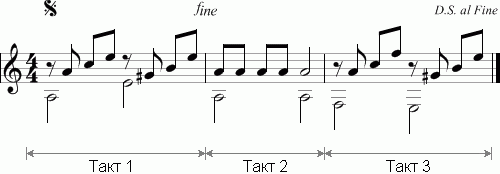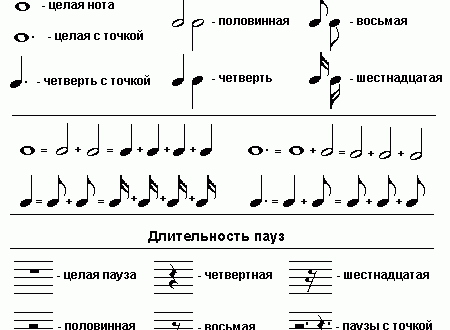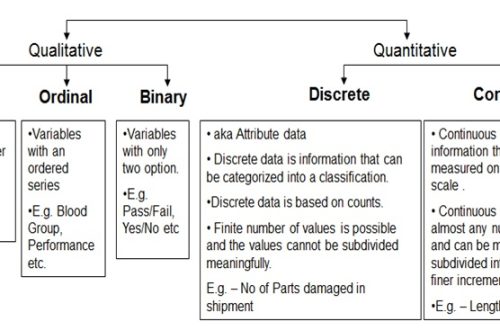
NOTE ABBREVIATION
How to decipher additional signs that are often found in music?
In musical writing, special notation is used that shortens the musical notation of a work. As a result, in addition to shortening the notation, it is also easier to read notes.
There are abbreviation signs that indicate various repetitions: within a bar, several bars, some part of a work.
Abbreviated notation is used, obliging to perform written one or two octaves higher or lower.
We will look at some ways to reduce musical notation, namely:
1. Reprise.
Reprise indicates the need to repeat part of the work, or the entire work. Look at the picture:

Figure 1-1. Reprise example
In the figure you see two reprise marks, they are circled in red rectangles. Between these signs lies a part of the work that must be repeated. Signs “look” at each other with dots.
If you want to repeat only one measure (even several times), you can use the following sign (similar to the percent sign):

Figure 1-2. Whole bar repeat
Since we are considering the repetition of one bar in both examples, both recordings are played as follows:

Figure 1-3. Music notation without abbreviation
those. 2 times is the same. In Figure 1-1, the repetition gives a reprise, in Figure 1-2, the “percentage” sign. It is important to understand that the percent sign duplicates only one bar, and the reprise can cover an arbitrarily large part of the work (even the entire work). Not a single repetition sign can indicate the repetition of some part of the measure – only the entire measure.
If the repetition is indicated by a reprise, but the endings of the repetition are different, then put brackets with numbers that indicate that this bar is to be played during the first repetition, this bar during the second, and so on. The brackets are called “volts”. The first volt, the second, and so on.
Consider an example with a reprise and two volts:

Figure 1-4. Example with reprise and volts
How to play this example? Now let’s figure it out. Everything is simple here. The recapitulation covers measures 1 and 2. Above the 2nd measure there is a volta with the number 1: we play this measure during the first passage. Above measure 3 there is a volt with number 2 (it is already outside the limits of the reprise, as it should be): we play this measure during the second pass of the reprise instead of measure 2 (volta number 1 above it).
So we play the bars in the following order: bar 1, bar 2, bar 1, bar 3. Listen to the melody. As you listen, follow the notes.
Results.
You got acquainted with two options for reducing musical notation: a reprise and a “percentage” sign. The reprise can cover an arbitrarily large part of the work, and the “percent” symbol repeats only 1 measure.
2. Repeats within a measure.
Repeat melodic figure.
If the same melodic figure is used within one measure, then such a measure can be written as follows:
Figure 2-1. Repeat melodic figure
Those. at the beginning of the measure, a melodic figure is indicated, and then, instead of redrawing this figure 3 more times, the need for repetition is simply indicated by flags 3 times. In the end, you actually play the following:

Figure 2-2. Performance of a melodic figure
Agree, the abbreviated record is easier to read! Please note that in our figure, each note has two flags (sixteenth notes). That is why there are two lines in the repetition signs.
Note repeat.
The repetition of one note or chord is indicated in a similar way. Consider this example:

Figure 2-3. Single note repeat
This entry sounds, as you probably already guessed, as follows:

Figure 2-4. Execution
Tremolo.
Fast, uniform, repeated repetition of two sounds is called the word tremolo. Figure 3-1 shows the sound of a tremolo, alternating two notes: “do” and “si”:

Figure 2-5. Tremolo sound example
In short, this tremolo will look like this:

Figure 2-6. Tremolo recording
As you can see, the principle is the same everywhere: one or two (as in tremolo) notes are indicated, the duration of which is equal to the sum of the notes actually played. The strokes on the stem of the note indicate the number of note flags to be played.
In our examples, we only repeat the sound of a single note, but you can also see abbreviations like this:

Figure 2-7. And it’s also a tremolo
Results.
Under this rubric, you have explored the various repetitions within a measure.
3. Signs of transfer to an octave.
If a small part of the melody is too low or high for easy writing and reading, then proceed as follows: the melody is written so that it is on the main lines of the musical staff. However, at the same time, they indicate that it is necessary to play an octave higher (or lower). How this is done, consider the figures:

Figure 3-1. 8va obliges to play an octave higher
Please note: 8va is written above the notes, and a part of the notes is also highlighted with a dotted line. All notes under the dotted line, starting from 8va, play an octave higher than written. Those. what is shown in the picture should be played like this:

Figure 3-2. Execution
Now consider an example when low notes are used. Take a look at the following picture (Agatha Christie’s tune):

Figure 3-3. Melody on additional lines
This part of the melody is written on additional lines below. We will use the notation “8vb”, marking with a dotted line those notes that need to be lowered by an octave (in this case, the notes on the stave will be written higher than the real sound by an octave):

Figure 3-4. 8vb obliges to play an octave lower
The writing has become more compact and easier to read. The sound of the notes remains the same.
An important point: if the whole melody sounds on low notes, then, of course, no one will draw a dotted line under the whole piece. In this case, the bass clef Fa is used. 8vb and 8va are used to shorten only part of a piece.
There is another option. Instead of 8va and 8vb, only 8 can be written. In this case, the dotted line is placed above the notes if you need to play an octave higher, and below the notes if you need to play an octave lower.
Results.
In this chapter, you learned about another form of musical notation abbreviation. 8va indicates to play an octave above what is written, and 8vb – an octave below what is written.
4. Dal Segno, Da Coda.
The words Dal Segno and Da Coda are also used to abbreviate musical notation. They allow you to flexibly organize repetitions of parts of a piece of music. We can say that it is like road signs that organize traffic. Only not along the roads, but along the score.
Dal Segno.
The sign ![]() indicates the place from which you will need to start the repetition. Please note: the sign only indicates the place where the replay starts, but it is still too early to play the replay itself. And the phrase “Dal Segno”, often shortened to “DS”, obliges to start playing the repeat. The “DS” is usually followed by instructions on how to play the replay. More on this below.
indicates the place from which you will need to start the repetition. Please note: the sign only indicates the place where the replay starts, but it is still too early to play the replay itself. And the phrase “Dal Segno”, often shortened to “DS”, obliges to start playing the repeat. The “DS” is usually followed by instructions on how to play the replay. More on this below.
In other words: perform a piece, meet a sign ![]() and ignore it. After you meet the phrase “DS” – start playing with the sign
and ignore it. After you meet the phrase “DS” – start playing with the sign ![]() .
.
As mentioned above, the phrase “DS” not only obliges to start the repetition (go to the sign), but also indicates how to proceed:
– the phrase “DS al Fine” means the following: ![]()
– the phrase “DS al Coda” obliges to return to the sign ![]() and play until the phrase “Da Coda”, then go to the Coda (start playing from the sign
and play until the phrase “Da Coda”, then go to the Coda (start playing from the sign ![]() ).
).
Code .
This is the final piece of music. It is marked with a sign ![]() . The concept of “Coda” is quite extensive, it is a separate issue. As part of the study of musical notation, for the time being, we only need the sign of the code:
. The concept of “Coda” is quite extensive, it is a separate issue. As part of the study of musical notation, for the time being, we only need the sign of the code: ![]() .
.
Example 1: Using “DS al Fine”.

Let’s take a look at the order in which the beats go.
Measure 1. Contains the sign Segno ( ![]() ). From this point we will start playing the replay. However, we have not yet seen indications for repetition (the phrase “DS…”) (this phrase will be in the second measure), so we
). From this point we will start playing the replay. However, we have not yet seen indications for repetition (the phrase “DS…”) (this phrase will be in the second measure), so we ![]() ignore the sign.
ignore the sign.
Also in the first measure we see the phrase “Da Coda”. It means the following: when we play a repeat, it will be necessary to switch from this phrase to Koda ( ![]() ). We also ignore it, since the repetition has not yet begun.
). We also ignore it, since the repetition has not yet begun.
Thus, we play Bar #1 as if there were no signs:

Bar 2. At the end of the bar we see the phrase “DS al Coda”. It means the following: you need to start the repetition (from the sign ![]() ) and play until the phrase “Da Coda”, then go to the Coda (
) and play until the phrase “Da Coda”, then go to the Coda ( ![]() ).
).
Thus, we play Bar No. 2 in full (the red color indicates the stage just completed):

…and then, following the indication of “DS al Coda”, we pass to the sign ![]() – this is Measure No. 1:
– this is Measure No. 1:

Bar 1. Attention: Here we play Bar No. 1 again, but this is already a repeat! Since we went to repeat from the phrase “DS al Coda”, we play until the instruction to switch to the “Da Coda” code (in order not to overload the picture, we erased the “old” arrows):

At the end of Bar No. 1, we meet the phrase “Da Coda” – we must go to the Coda ( ![]() ):
):
Bar 3. And now we play from the Coda sign ( ![]() ) to the end:
) to the end:

Result. Thus, we got the following sequence of bars: Bar 1, Bar 2, Bar 1, Bar 3.
Clarification about Coda. Once again, let’s clarify that the term “Coda” has a deeper meaning than shown in the example. Coda – the final part of the work. Coda is not taken into account when you, when parsing a work, determine its construction.
In the framework of this article, we considered the abbreviation of musical notation, therefore, we did not dwell on the concept of Coda in detail, but used only its designation: ![]() .
.
Outcome.
You have learned many useful abbreviations for musical notation. This knowledge will be very useful to you in the future.





